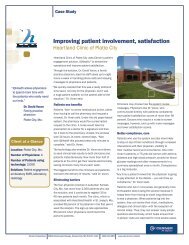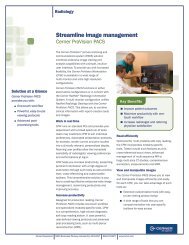The ABCs of systemic healthcare reform - Cerner Corporation
The ABCs of systemic healthcare reform - Cerner Corporation
The ABCs of systemic healthcare reform - Cerner Corporation
- No tags were found...
You also want an ePaper? Increase the reach of your titles
YUMPU automatically turns print PDFs into web optimized ePapers that Google loves.
Certain <strong>of</strong> our competitors have greater financial, technical, product development, marketing and other resources than us and<br />
some <strong>of</strong> our competitors <strong>of</strong>fer s<strong>of</strong>tware solutions that we do not <strong>of</strong>fer. Our principal existing competitors are set forth above<br />
under Part I, Item 1 Competition.<br />
In addition, we expect that major s<strong>of</strong>tware information systems companies, large information technology consulting service<br />
providers and system integrators, start-up companies and others specializing in the <strong>healthcare</strong> industry may <strong>of</strong>fer competitive<br />
s<strong>of</strong>tware solutions, devices or services. We face strong competitors and <strong>of</strong>ten face downward price pressure. Additionally, the<br />
pace <strong>of</strong> change in the <strong>healthcare</strong> information systems market is rapid and there are frequent new s<strong>of</strong>tware solution<br />
introductions, s<strong>of</strong>tware solution enhancements, device introductions, device enhancements and evolving industry standards<br />
and requirements. <strong>The</strong>re are a limited number <strong>of</strong> hospitals and other <strong>healthcare</strong> providers in the U.S. HIT market. As costs fall,<br />
technology improves, and market factors continue to compel investment by <strong>healthcare</strong> organizations in solutions and services<br />
like ours, market saturation in the U.S. may change the competitive landscape in favor <strong>of</strong> larger, more diversified competitors<br />
with greater scale.<br />
Risks Related to Our Stock<br />
<strong>The</strong> ongoing adverse financial market environment and uncertainty in global economic conditions could negatively affect<br />
our business, results <strong>of</strong> operations and financial condition. Our operating results may be impacted by the health <strong>of</strong> the global<br />
economy. Adverse economic conditions may cause a slowdown or decline in client spending which could adversely affect our<br />
business and financial performance. Our business and financial performance, including new business bookings and collection<br />
<strong>of</strong> our accounts receivable, may be adversely affected by current and future economic conditions (including a reduction in the<br />
availability <strong>of</strong> credit, higher energy costs, rising interest rates, financial market volatility and recession) that cause a slowdown or<br />
decline in client spending. Further, the ongoing global financial crisis may also limit our ability to access the capital markets at<br />
a time when we would like, or need, to raise capital, which could have an impact on our ability to react to changing economic<br />
and business conditions. Accordingly, if the global financial crisis and current economic downturn continue or worsen, our<br />
business, results <strong>of</strong> operations and financial condition could be materially and adversely affected.<br />
Our quarterly operating results may vary which could adversely affect our stock price. Our quarterly operating results have<br />
varied in the past and may continue to vary in future periods, including, variations from guidance, expectations or historical<br />
results or trends. Quarterly operating results may vary for a number <strong>of</strong> reasons including accounting policy changes, demand<br />
for our solutions, devices and services, the financial condition <strong>of</strong> our clients and potential clients, our long sales cycle,<br />
potentially long installation and implementation cycles for larger, more complex and higher-priced systems and other factors<br />
described in this section and elsewhere in this report. As a result <strong>of</strong> <strong>healthcare</strong> industry trends and the market for our <strong>Cerner</strong><br />
Millennium solutions, a large percentage <strong>of</strong> our revenues are generated by the sale and installation <strong>of</strong> larger, more complex and<br />
higher-priced systems. <strong>The</strong> sales process for these systems is lengthy and involves a significant technical evaluation and<br />
commitment <strong>of</strong> capital and other resources by the client. Sales may be subject to delays due to changes in clients' internal<br />
budgets, procedures for approving large capital expenditures, competing needs for other capital expenditures, availability <strong>of</strong><br />
personnel resources and by actions taken by competitors. Delays in the expected sale, installation or implementation <strong>of</strong> these<br />
large systems may have a significant impact on our anticipated quarterly revenues and consequently our earnings, since a<br />
significant percentage <strong>of</strong> our expenses are relatively fixed.<br />
Revenue recognized in any quarter may depend upon our and our clients’ abilities to meet project milestones. Delays in<br />
meeting these milestone conditions or modification <strong>of</strong> the project plan could result in a shift <strong>of</strong> revenue recognition from one<br />
quarter to another and could have a material adverse effect on results <strong>of</strong> operations for a particular quarter.<br />
Our revenues from system sales historically have been lower in the first quarter <strong>of</strong> the year and greater in the fourth quarter <strong>of</strong><br />
the year, primarily as a result <strong>of</strong> clients’ year-end efforts to make all final capital expenditures for the then-current year.<br />
Our sales forecasts may vary from actual sales in a particular quarter. We use a “pipeline” system, a common industry<br />
practice, to forecast sales and trends in our business. Our sales associates monitor the status <strong>of</strong> all sales opportunities, such<br />
as the date when they estimate that a client will make a purchase decision and the potential dollar amount <strong>of</strong> the sale. <strong>The</strong>se<br />
estimates are aggregated periodically to generate a sales pipeline. We compare this pipeline at various points in time to<br />
evaluate trends in our business. This analysis provides guidance in business planning and forecasting, but these pipeline<br />
estimates are by their nature speculative. Our pipeline estimates are not necessarily reliable predictors <strong>of</strong> revenues in a<br />
particular quarter or over a longer period <strong>of</strong> time, partially because <strong>of</strong> changes in the pipeline and in conversion rates <strong>of</strong> the<br />
pipeline into contracts that can be very difficult to estimate. A negative variation in the expected conversion rate or timing <strong>of</strong> the<br />
pipeline into contracts, or in the pipeline itself, could cause our plan or forecast to be inaccurate and thereby adversely affect<br />
business results. For example, a slowdown in information technology spending, adverse economic conditions or a variety <strong>of</strong><br />
other factors can cause purchasing decisions to be delayed, reduced in amount or cancelled, which would reduce the overall<br />
pipeline conversion rate in a particular period <strong>of</strong> time. Because a substantial portion <strong>of</strong> our contracts are completed in the latter<br />
part <strong>of</strong> a quarter, we may not be able to adjust our cost structure quickly enough in response to a revenue shortfall resulting<br />
from a decrease in our pipeline conversion rate in any given fiscal quarter(s).<br />
<strong>The</strong> trading price <strong>of</strong> our common stock may be volatile. <strong>The</strong> market for our common stock may experience significant price<br />
and volume fluctuations in response to a number <strong>of</strong> factors including actual or anticipated variations in operating results,<br />
rumors about our performance or solutions, devices and services, changes in expectations <strong>of</strong> future financial performance or<br />
31
















